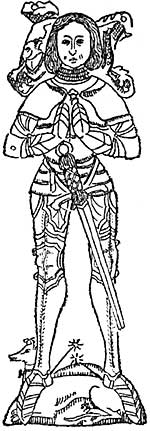ABOUT NOTTINGHAMSHIRE: ITS PLACES AND ITS PEOPLE,
by CORNELIUS BROWN, F.R.S.L., author of "LIVES OF NOTTS. WORTHIES" and
other works.
Chapter XL. The Cliftons of Clifton
 Sir Robert Clifton.
Sir Robert Clifton.Everyone who lives, or has lived, in Nottingham will be well aware that there is no walk more pleasant or picturesque for the denizens of the busy town than that which leads through Wilford by the banks of the silvery Trent to Clifton. The little village, nestling amidst the trees, and its famous Grove, which painters have often sketched and of whose sylvan glories poets have sung, is a favourite resort for those who wish to enjoy a few hours' relaxation in the rural quietude of a pretty and peaceful spot. The charms of Clifton Grove, a beautiful avenue of stately trees, at the foot of which flows the swift stream of the Trent, prove a constant source of attraction, and the interest of the place is heightened by romantic tales and legends which are associated with this delightful locality. To Kirke White the shady path, from whose heights a fine view of the broad vale of the Trent and of the town of Nottingham can be seen, was a frequent source of pleasure, and to his "Clifton Grove" those readers should refer who wish a poetic description of the scene, and a vivid narrative of the fair maid of Clifton and her strange career. Our present purpose is to say something of the village and its history, and more especially of the famous family with which it has happily been connected for many centuries past.
For the Cliftons, who have made the hall their home, and who lie buried within the little church a short distance from the manor, have been no ordinary people. They have exercised a wide influence over affairs of State, have participated in the glories of many a hard fought battle, and have upheld the honour and fame of their native county in important spheres of public duty ere they were laid to rest within the sacred edifice, around which "the rude forefathers of the hamlet sleep."
Though the village has always been very small in point of population, the manor is one of some significance. Thoroton tells us that as far back as the days of Edward the Confessor it was "a very eminent manor," and belonged to the famous Countess Godiva of whom, and whose Nottinghamshire property, we had occasion to speak in our last article. When the Conqueror came it became the possession of William Peverel, and there were then residing within the locality four sochmen, nineteen villains, and eight bordars, for whose accommodation there was a church and a mill, and twelve acres of meadow. The Soc extended to Barton, Wilford, and other villages in the vicinity, and Clifton became one of the principal manors of the demesne of William Peverel. In the time of Henry II. it reverted to the Crown, and was granted to other owners, but the family which had taken its surname from the village, and was coming so far to the forefront that its members had gained the honour of knighthood, did not obtain the lordship of their native place until the close of the reign of Henry III, when Sir Gervase de Clifton purchased the manor of Gerard de Rhodes. Very appropriate it was that the people who were making the name of Clifton honoured should assume the ownership of the village, and from this time forward it remained their principal seat. Sir Gervase was High Sheriff of the counties of Notts, and Derby in the reign of Edward I., and had granted to him by Robert de Tibtot, constable of Nottingham Castle, a demise of the castle and precincts for a term of years, and hence probably arose the title of "Guardianus Castelli de Nottingham" assigned to his family in the old Visitations. As we do not purpose entering into a dry-as-dust pedigree, we select for notice only a few of the more noteworthy of the Cliftons, and revert to such of their doings as may be of general interest. Sir Gervase was sometimes called of Wilford, and a branch of the family kept the surname of Wilford, whereof one Gervase de Wilford was Chief Baron of the Exchequer, 24th Edward III. He presided over the Court until 1361, when he was exonerated from service, being broken down by age. Sir John Clifton, who married Katherine, sister and co-heir of Sir Hugh Cressy of Hodsock, assisted Henry IV. in his struggle with the Percies, and was slain in the famous battle of Shrewsbury, when Henry Percy (Hotspur) was lulled and his party dispersed.
A relative of the warrior who fell at Shrewsbury, by some said to be his son, and by others his brother or cousin, gained great renown in the reign of Henry VI. He bore the favourite family name of Gervase, and by his marriage with Maud, niece of the great Lord Cromwell, became possessed of lands in Kent. He took an active part in the French wars, and was taken prisoner at Pontoise after gallantly defending that place against the overwhelming forces of the enemy. In subsequent years he entered the navy, and held important commands, receiving a grant of 400 marks from the Exchequer in 1450 for the notable services he had rendered and the costs he had incurred "for and about the keeping of the sea and the rebuking of our enemies," Adhering closely to the cause of his Royal master, he fought against the Yorkists at Towton in 1461, and though the Lancastrian hopes were shattered on that fatal field, he did not desert the fallen house. In 1468 he was accused of conspiring to effect the release of Henry, then a prisoner in the Tower, and was brought before another famous Nottinghamshire man, Chief Justice Markham, at the Guildhall, London. Either the evidence was inconclusive, or powerful influence was exercised in his behalf, for he obtained his release, and in 1470 received a free pardon. But the old loyal spirit did not die out, and what followed is thus graphically narrated by Mr. Stevenson:—Upon the expulsion of Edward IV., and reinstatement of Henry VI. as King by Warwick, Sir Gervase, with other Lancastrians, assembled round the standard of King Henry. He joined the army under the Queen, which assembled to resist Edward upon his return, and was with that ill-fated force at the battle of Tewkesbury, fought May 4th, 1471. When the defeat of the Lancastrians became evident, the Duke of Somerset, Sir Gervase Clifton, and fourteen other Lancastrians took refuge in the Abbey Church, and threw themselves in front of the altar, relying upon the sanctity of the place for their protection. Here they were discovered by King, Edward, who rushed into the church sword in hand, and his followers would doubtless have slain the refugees where they stood, had not a priest bearing the Holy Sacrament thrown himself in front of the advancing savages and reminded them of the sanctity of the edifice. Hereupon King Edward, possibly remembering how his wife and children owed their lives to the respect for sanctuaries, pardoned all the Lancastrians who had taken refuge in the church. This was on Saturday. On the Monday, however, Sir Gervase and the other refugees, who might have escaped in the interval if they had not placed so much reliance upon the Royal pardon, were brought before the Duke of Gloucester (hereafter King Richard III.) and the Duke of Norfolk, who condemned them to death. This infamous sentence was carried into effect. A scaffold was erected in Tewkesbury market-place, and upon this Sir Gervase Clifton and his companions were beheaded.
